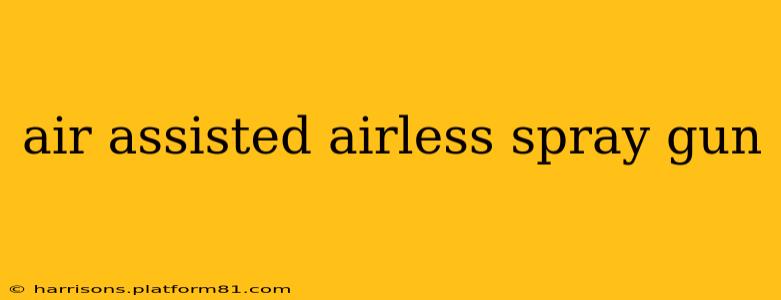Air assisted airless spray guns represent a powerful hybrid technology, combining the best features of both airless and conventional air spray systems. This blend delivers superior atomization, improved transfer efficiency, and enhanced control, making them a versatile choice for a wide range of applications. This guide delves into the intricacies of air assisted airless spray guns, exploring their benefits, applications, and considerations for optimal performance.
What is an Air Assisted Airless Spray Gun?
An air assisted airless spray gun utilizes a pump to generate high pressure, forcing paint or coating through a small nozzle. Unlike pure airless systems, however, it introduces compressed air at the nozzle to further atomize the material. This dual action leads to a finer spray pattern, reduced overspray, and a smoother finish. The air assistance allows for better control over the spray pattern and material deposition, resulting in less material waste and a higher quality finish.
How Does an Air Assisted Airless Spray Gun Work?
The process begins with the airless pump pressurizing the fluid. This high-pressure fluid then travels through the gun's internal passages. Just before the nozzle, compressed air is introduced. This air stream interacts with the high-pressure fluid stream, further atomizing the material into extremely fine droplets. The resulting spray is both efficient and provides excellent control for precise application.
What are the Advantages of Air Assisted Airless Spray Guns?
- Improved Atomization: The addition of compressed air significantly refines the atomization process, leading to a much finer spray pattern compared to standard airless spray guns. This translates to a smoother, more even finish with less texture.
- Reduced Overspray: The controlled atomization minimizes overspray, leading to less material waste and a cleaner work environment. This is crucial for both cost savings and environmental considerations.
- Enhanced Transfer Efficiency: The precise spray pattern results in more of the material reaching the target surface, increasing transfer efficiency and reducing the amount of material required for the job.
- Better Control and Versatility: Air assisted airless guns offer greater control over the spray pattern and material application, making them suitable for a wider variety of applications and materials. This precision is beneficial for both detailed work and large-scale projects.
- Suitable for Various Materials: These guns can handle a broad range of materials, including paints, stains, lacquers, primers, and other coatings. This versatility makes them a valuable tool in various industries.
What are the Disadvantages of Air Assisted Airless Spray Guns?
- Higher Initial Cost: Air assisted airless spray guns generally have a higher purchase price than standard airless spray guns.
- Increased Complexity: The addition of the air compressor adds complexity to the system, potentially leading to increased maintenance requirements.
- Air Compressor Requirements: You'll need a reliable air compressor to provide the necessary compressed air for operation.
- Potential for Increased Noise: The addition of the air compressor can increase the overall noise level during operation.
What are the Best Applications for Air Assisted Airless Spray Guns?
Air assisted airless spray guns excel in situations requiring a fine finish and efficient material usage. Some prime examples include:
- Automotive Refinishing: The superior atomization and control are ideal for achieving flawless automotive paint jobs.
- Cabinet Finishing: The ability to apply even coats to intricate surfaces makes them well-suited for high-quality cabinet finishing.
- Furniture Refinishing: Similar to cabinet finishing, the precision and control make these guns ideal for furniture refinishing projects.
- Industrial Coating Applications: Their efficiency and ability to handle various materials make them suitable for industrial coating tasks.
What are the Different Types of Air Assisted Airless Spray Guns?
Air assisted airless spray guns come in various configurations, differing in features like nozzle size, fluid capacity, and pressure capabilities. The specific type best suited for a particular task depends on the material being sprayed and the desired finish.
How to Choose the Right Air Assisted Airless Spray Gun?
Choosing the right gun involves considering factors such as:
- Material Viscosity: The thickness of the material will influence the required pressure and nozzle size.
- Spray Pattern: Select a gun with a spray pattern that matches the application needs.
- Pressure Settings: Adjustability in pressure settings allows for customized control and precision.
- Durability and Build Quality: Invest in a durable and well-constructed gun to ensure long-term performance and reliability.
Maintaining Your Air Assisted Airless Spray Gun
Regular maintenance is crucial for optimal performance and longevity. This includes cleaning the gun thoroughly after each use, checking for leaks, and replacing worn parts as needed. Following the manufacturer's recommendations for maintenance will help to extend the lifespan of your equipment.
This comprehensive guide aims to provide a thorough understanding of air assisted airless spray guns, highlighting their advantages, applications, and considerations for selection and maintenance. Remember to always consult the manufacturer's instructions for safe and effective operation.
